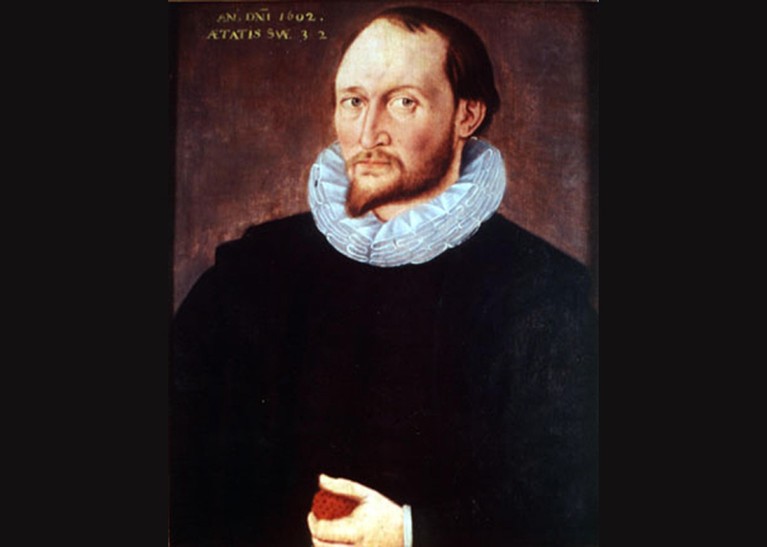
A portrait believed to be of Thomas Harriot, painted around 1602.Credit: The Picture Art Collection/Alamy
Thomas Harriot: A Life in Science Robyn Arianrhod Oxford University Press (2019)
The phrase ‘publish or perish’ came into use in the twentieth century to encapsulate academic pressures. It is also a lesson from the life of Thomas Harriot, who lived when there were no academic journals, and who never taught at a university.
A contemporary of William Shakespeare, Harriot was an English mathematician, astronomer and natural philosopher whose original work bears comparison with that of Johannes Kepler and Galileo Galilei. Yet, outside the enthusiastic circle of historians of early modern science who call themselves Harrioteers, his name is almost unknown: he never published his mathematical work. In Thomas Harriot: A Life in Science, mathematician Robyn Arianrhod sets out to explain how historians have nevertheless been able to place him, almost four centuries after his death in 1621, among the founders of modern science.
Harriot is elusive. The earliest known document concerning him lists him as a “plebeian” scholar registering to study at the University of Oxford in 1577. He never married and left no children. By 1583, he was employed by Walter Raleigh, naval commander, explorer and favourite of Queen Elizabeth I, to teach astronomy and navigation — a field he greatly improved — to sea captains. He was celebrated in his lifetime by the writer Gabriel Harvey as among the “profound mathematicians”, alongside Thomas Digges and John Dee. Afterwards, he was largely forgotten.
He has a higher profile in the United States, thanks to the one work he did publish. A Brief and True Report of the New Found Land of Virginia is a first-person account of a 1585–86 voyage sent by Raleigh to survey what is now part of North Carolina. The party landed on Roanoke Island and surveyed it and the nearby mainland; almost all its members returned to England in June 1586. Harriot was “employed in discovering”. His report, published in 1588, includes the first detailed English description of the language and customs of the Algonquian people, and of the region’s natural resources and climate. Arianrhod shows that his interest in local people was far from typical: he learnt their language, admired how they interplanted beans, squashes and maize (corn), and respected their religion. Meanwhile, the military expedition leaders fatally soured relations by overreacting to perceived wrongdoing and making unreasonable demands.
Previous biographers — the US authors Henry Stevens in 1900 and John Shirley in 1983 — were prompted by the Brief and True Report. Neither fully addressed Harriot’s scientific contributions, as Arianrhod tries to do. Harriot’s will mentioned a trunk full of mathematical papers. A few were circulated and partly published by friends such as the mathematician Walter Warner after his death, but what became of the collection was unknown until 1784, when it turned up in some disorder at Petworth House, home to heirs of the ninth Earl of Northumberland, Harriot’s patron after Raleigh. Only since the mid-twentieth century have scholars made sense of the thousands of manuscript sheets.
What they reveal is astonishing. To mention only a portion of Harriot’s work, he discovered Snell’s law of refraction two decades before mathematician Willebrord Snell; formulated laws of motion and falling bodies independently of Galileo and decades before Isaac Newton; produced the first drawing of the Moon through a telescope and made important observations of sunspots, again independently of Galileo; played with binary arithmetic nearly a century before Gottfried Wilhelm Leibniz; and was the first to develop fully symbolic algebra. There are well-grounded suspicions that René Descartes saw some of Harriot’s papers before publishing The Geometry in 1637.
Where Harriot falls down, say some scholars, is that he did not draw his observations into coherent theory. It’s possible he just never got round to it. Harriot spent his adult life in the households of Raleigh and Northumberland. They paid him generously, and all appearances suggest that he was a friend rather than a servant. However, both were players on the volatile political scene, and malicious rumours of atheism and necromancy did the rounds. Soon after James I succeeded Elizabeth I in 1603, Raleigh was convicted of treason, and Northumberland of lesser charges when a cousin was involved in the Gunpowder Plot to murder the king. Both were imprisoned in the Tower of London; Raleigh was executed in 1618.
Harriot spent an anxious few weeks in prison because of his association with Northumberland; he might have felt the need to keep his head down over the years. He died aged about 60 from cancer of the nose, possibly caused by his enthusiasm for tobacco after his American adventure.
The lack of finished work makes evaluating his contribution complex. Arianrhod does not hesitate to call him a genius, and the evidence she presents is impressive. Yet she fully explores his rightful position in the pantheon only in a page-long endnote; I think this shortchanges the “general reader” she seeks to enlighten. Some might find her technical passages challenging, although they are necessary to her argument. And it is irksome to see diagrams relating to Harriot’s navigational work in an appendix, rather than with the text they illustrate.
Has Arianrhod, as she intended, “put a human face to scientific inquiry in the Elizabethan and Jacobean worlds”? She has revealed a scientific mind, but the face is more elusive: the one supposed portrait of Harriot is of unknown provenance and, because of a discrepancy in dates, some historians doubt it is him.
This black-clad, driven, sceptical man, “contented with a private life for the love of learning” as he wrote to his captors, still declines wholly to step into the light.

 Archive of wonders
Archive of wonders
 Much Ado About Science
Much Ado About Science
 Tudor technology: Shakespeare and science
Tudor technology: Shakespeare and science







